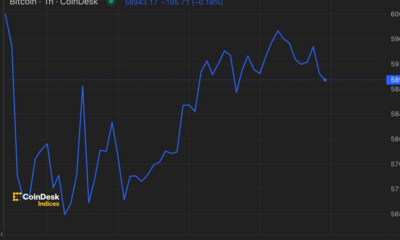News
Why can’t more Texans profit like Bitcoin miners for using less power?

Your donation to The Texas Tribune will help investigative journalism that impacts state policies and politics. It is the last week of our Spring Member Drive, and our newsroom relies on readers like you who support independent Texas news. Donate today.
When the news broke that Bitcoin mining company Riot Platforms made $32 million by reducing — or being willing to reduce if needed — its energy use last August in Texas, the outrage was immediate.
The state’s grid operator had frequently asked Texans to conserve electricity during sweltering summer heat, and many saw their power bills soar as they tried to stay cool. Meanwhile the state grid operator and an electricity provider effectively gave millions to a company whose industry is notorious for using gobs of electricity.
Riot made that giant sum of money because of how the state’s electricity market is designed. Companies that use large amounts of power, such as manufacturers or petrochemical plants, have long profited in similar ways.
There are two ways that large power users can make money on the state’s main power grid, according to industry experts. The Electric Reliability Council of Texas, which operates the grid, pays large industrial users that promise to reduce their power consumption as needed, giving ERCOT some wiggle room in case a power plant unexpectedly fails or power demand is higher than forecast.
A company such as Riot also can profit by buying power at negotiated rates ahead of time — retail power companies allow big companies to lock in prices that way — then selling it back into the state market when energy prices soar during extreme heat or cold. In Riot’s case, when electricity prices soared during the summer heat wave, Riot sold power back to TXU, a Dallas-based electricity provider, which sold it back to the grid.
In a September statement, Riot characterized its actions as helping to stabilize the grid.
Riot’s windfall highlighted for everyday power consumers just how much the Texas market can benefit businesses. Critics saw particular problems with cryptocurrency.
Lee Bratcher, president of the Texas Blockchain Council, a group promoting cryptocurrency growth and innovation in Texas, said in an email that cryptocurrency operations can benefit the grid because they are able to reduce or completely shut down their operations quickly.
“Bitcoin miners can use excess power overnight and on days where demand is normal, and they can turn off on very hot or very cold days when power is scarce and electricity prices are high,” Bratcher said in an email.
But Mandy DeRoche, deputy managing attorney in the clean energy program at Earthjustice, a nonprofit environmental law group, said crypto mining businesses shouldn’t be praised for reducing power on the grid when they are using so much to begin with.
“I think that the rewards for their behavior are so lucrative and unfair,” DeRoche said, adding, “It’s like we’re bending over backwards to give money to the (crypto) miner for putting the strain on the grid and the system in the first place.”
China, which was one of the largest crypto mining hubs in the world, banned crypto mining in 2021, concerned about virtual currencies being used for criminal activity and disrupting financial systems. Cryptocurrency operations began opening in Texas, which as of March was home to five of the 10 largest Bitcoin mines in the U.S., according to an April investigation by The New York Times.
Some industry experts have advocated for Texas residents to be able to reap the same sort of benefits for using less power at critical times. Called “demand response,” it’s a way for power companies to pay or credit customers who agree to reduce their power usage when demand is high, by adjusting their thermostats or timing their energy-intensive activities like charging electric vehicles or running pool pumps at times when power demand is low.
Electricity providers such as Austin Energy and Reliant already have programs that pay customers to let the providers adjust their smart thermostats when necessary but the benefit is small. For residential customers, that typically translates to one-time bill credits that can range from $25 to $85.
Ed Hirs, a University of Houston lecturer and energy market expert, said he’s worried that more Bitcoin mines coming to the state will mean higher electricity prices for Texans.
“Why can’t I get $5 a kilowatt an hour for shutting down my power?” Hirs said. “Why are these guys getting a sweetheart deal?”
This summer, one of the hottest in recorded Texas history, Fort Worth resident Terri Rimmer said she conserved because she feared power being cut altogether. Rimmer remembers losing electricity for five days during the deadly 2021 winter storm, when ERCOT called for power cuts to millions of Texans because power generators failed in the extreme cold and the remaining power sources couldn’t keep up with the high demand.
Rimmer said temperatures dropped as low as 25 degrees inside her home during the power outage. She bundled up in layers of clothing and blankets and shared her bed with her cat to stay warm.
That month, a Bitcoin mine that Riot Platforms acquired, Whinstone, received a $125 million windfall by selling power back to the grid, according to an investigation by the Tech Transparency Project.
This summer, when ERCOT warned of tight grid conditions because of unprecedented power demand, Rimmer, 57, turned off her air conditioning, closed her blinds and blackout curtains and put an ice pack on her chest to try to stay cool. Sweat glistened on her face.
“I wasn’t like this before,” Rimmer said. “I didn’t conserve until that winter storm hit. It’s truly traumatizing. For me it changed how I do things.”
Earning more from the grid than from selling Bitcoin
According to Bratcher, there are more than 20 industrial-scale Bitcoin mining operations in Texas that can collectively consume up to 2,300 megawatts of energy a day — enough to power about 460,000 homes during times of high demand in Texas. They house computers that run constantly to produce cryptocurrencies, decentralized digital currencies used as alternatives to government-backed, traditional currencies.
Crypto miners essentially compete to solve complex math problems that, when verified, produce one Bitcoin or other cryptocurrency that the companies can either hold as an asset or sell. The more computers they have and the longer they run, the better their chances of solving the problem the fastest.
“Essentially every miner is running the exact same algorithm, and it really is just a matter of luck,” said Samantha Robertson, a member of the corporate strategy team for Bitdeer, another Bitcoin company with an operation in Rockdale. “In order to increase your chances, it makes sense to have these computers running at scale.”
But if the value of Bitcoin is low and the cost of electricity is high, crypto companies can make more money selling power than mining Bitcoin. In August 2023, Riot reported selling 300 Bitcoins for a net proceeds of $8.6 million. Meanwhile, the company said it earned $24.2 million in credits to its electric bill for selling power back to the grid.
In September 2023, Riot said it earned $9 million in net proceeds from Bitcoin sales and $11 million in credits for selling power back to the grid.
Robertson said Bitdeer and other cryptocurrency companies are not doing anything different than other industries by selling power back to the grid when demand and prices rise.
“Quite frankly we’re just playing by those rules,” Robertson said.
Because of how much power cryptocurrency mines use and how quickly they can reduce their power consumption — which can help relieve stress on the grid when demand is high — it is important for ERCOT to work closely with them, ERCOT President and CEO Pablo Vegas said in a September interview.
“I’m interested in their operating characteristics,” Vegas said.
The electricity-selling agreements between retail power companies like TXU and cryptocurrency businesses like Riot aren’t public, so it’s difficult to discover exactly how the companies are benefiting from the current ERCOT rules, said DeRoche, of EarthJustice.
“There’s very little regulation, there’s no reporting standards,” DeRoche said during a September virtual press conference featuring cryptocurrency opponents from different organizations. “It makes it difficult to track and to get a complete picture of the total impacts.”
Eric Goff, a member of an ERCOT task force that was formed to help manage power demand from large industrial users, said ERCOT has proposed rules to have large power users such as Bitcoin mines register with ERCOT so it could track their impacts on the grid. The rules don’t have a specific deadline to be implemented, he said.
Environmental advocates also argue that there is a less energy-intensive way, called proof of stake, to create Bitcoin that doesn’t require computers to run so many calculations. The Texas Coalition Against Cryptomining held a weeklong protest in October to oppose Riot’s plans to build a cryptocurrency operation near the Central Texas city of Corsicana. Coalition Founder Jackie Sawicky faulted crypto businesses for failing to reduce their energy use.
“Why are we tolerating this?” Sawicky asked in an interview. “It’s insane.”
The potential of residential demand response
In Texas, at least seven electric providers, including Austin Energy, Reliant and CPS Energy, offer residential demand response programs that typically let the providers remotely adjust customers’ smart thermostats a few degrees during critical periods when energy demand is high. Customers have to sign up for the programs.
Other companies such as OhmConnect are working with smart plugs in homes. Don Whaley, senior advisor to business at OhmConnect, said customers can plug devices such as refrigerators, lamps and other ordinary household electrical appliances into the smart plugs, allowing the company to adjust power consumption remotely when necessary.
While tens of thousands of Texans do participate in programs where they agree to reduce energy use — Austin Energy said its program has 33,000 active smart thermostats, while Reliant said 100,000 customers are enrolled in its program — the amount paid to residential customers is small.
Most companies give their customers credits that reduce their electricity bills. For example, Reliant and Direct Energy give out a one-time $25 credit for enrolling in the program, Austin Energy offers a $50 credit for enrolling and a yearly $25 credit for staying, and CPS Energy customers receive an $85 enrollment credit and an additional $30 for each year they participate.
Other companies incentivize through point systems. OhmConnect customers can earn points or currency called Watts that can be traded in for real money, gift cards or to make a donation to charity. Gexa Energy’s Green Rewards program gives residential customers Active Saver Rewards points that customers can redeem as credits to lower their power bills.
Octopus Energy, a Houston-based retail electric provider that has a startup-feeling office with exposed brick, said its Texas customers can sign up for programs that allow Octopus to adjust smart home thermostats and electric vehicle chargers based on power prices, which allows them to offer lower-cost power.
ERCOT is also running pilot projects in the Dallas and Houston areas that let people with Tesla Powerwall batteries sell their extra electricity onto the state grid when it’s needed. This concept is known as a “virtual power plant” and works by adding up lots of small power resources to create a meaningful amount of supply.
Texas Public Utility Commissioner Will McAdams said in an August interview that ERCOT needed to use all available strategies to get power onto the grid.
“It was now or never,” McAdams said. “We needed to get this off the ground and allow our very interested Texas consumers to better engage in the ERCOT system.”
Critics such as energy consultant Doug Lewin say the Public Utility Commission needs to get to a point where it can expand the pilot projects and make the concept a permanent part of how the grid works. Lewin also urged the PUC to put regulations in place so all residential customers can benefit from reducing power use on the grid just like large customers do.
“This is absolutely critical if we’re going to have either a reliable or affordable grid,” Lewin said.
A study by the American Council for an Energy-Efficient Economy, a nonprofit research advocacy group, found that if Texas implements statewide demand response and energy efficiency programs for residential customers and businesses from 2024 to 2030, Texas could reduce peak summer electricity demand by 15 gigawatts and the peak winter demand by 25 gigawatts.
“Residential load is a small thing.” Whaley said. “But if we start getting this general acceptance to where people go, ‘Oh okay yeah, I can go from 72 to 78 degrees for an hour because that’s what the grid needs,’ then you start seeing real reductions in the market, to start seeing real impact.”
Alejandra Martinez contributed to this story.
Disclosure: CPS Energy, Octopus Energy, Texas Blockchain Council, The New York Times and the University of Houston have been financial supporters of The Texas Tribune, a nonprofit, nonpartisan news organization that is funded in part by donations from members, foundations and corporate sponsors. Financial supporters play no role in the Tribune’s journalism. Find a complete list of them here.
Correction, Jan. 5, 2024 at 4:06 p.m.:
A previous version of this story incorrectly stated that Bitcoin mining company Riot deleted a statement from its website that said its practice of selling electricity back to the state power grid helps to stabilize the grid.
News
Ether Drops Further After ETF Launch

Key points
- Spot ether ETFs began trading in the U.S. today, with the funds initially having more than $10 billion in collective assets under management.
- Analysts expect the launch of spot ether ETFs to have a net negative impact on the underlying price of ether in the near term, due to expected outflows from the pre-existing Grayscale Ethereum Trust.
- Spot Bitcoin ETFs continue to see strong inflows, with BlackRock’s IBIT alone seeing more than $500 million in inflows on Monday.
- Franklin Templeton, a spot ETF issuer on bitcoin and ether, has invested in a project that intends to bring Ethereum technology to Bitcoin.
Nine-point ether exchange-traded funds (ETFs)) started trading on the stock market on Tuesday, but all the optimism ahead of their approval did not translate into gains for the cryptocurrency markets.
Ether (ETH), the native cryptocurrency of the Ethereum blockchain, dropped less than 1% around the $3,400 level as of 1:30 PM ET, while Bitcoin (BTC) fell more than 2% to around $66,000.
Ether ETFs’ Debut Isn’t as Flashy as Bitcoin ETFs’
Spot ether ETFs began trading at just over $10 billion assets under management (AUM)), according to Bloomberg Intelligence analyst James Seyffart, most of that money is in the current Grayscale Ethereum Trust (ETHE) which has now been converted into an ETF.
“In the long term, Grayscale will simultaneously have the highest and lowest fees in the market. The asset manager’s decision to keep its ETHE fee at 2.5% could lead to outflows from the fund,” Kaiko Research said in a note on Monday.
Outflows from ETHE, if they occur, would be similar to those faced by Grayscale’s Bitcoin Trust (GBTC) after spot bitcoin ETFs began trading in January of this year, most likely due to high fees for the two original funds. Grayscale’s existing fund charges 2.5% fees, while a new “mini” ether ETF will charge 0.15% and commissions for other ETFs are set at 0.25% or less.
Such outflows could impact the price of ether and market sentiment.
“There could be a pullback shortly after the launch of Ethereum spot ETFs, i.e. outflows from Grayscale Ether Trust could dampen market sentiment in the short term,” Jupiter Zheng, a partner at Hashkey Capital’s liquid fund, told The Block.
But Grayscale remains optimistic.
“Compared to the splashy debut of spot bitcoin ETPs in January, the launch of ethereum ETPs has been relatively muted,” said Zach Pandl, Grayscale’s head of research, adding that investors may be “undervaluing” ether ETFs that are “coming to the U.S. market in tandem with a shift in U.S. cryptocurrency policy and the adoption of tokenization by major financial institutions.”
Bitcoin ETF Inflows Continue to Rise
As for bitcoin, there is clearly no lack of demand for spot ETFs, such as BlackRock’s iShares Bitcoin Trust (IBITS) recorded its sixth-largest day of inflows in its short history on Monday, at $526.7 million, according to data from Farside Investors. Daily inflows for the overall spot bitcoin ETF market also hit their highest level since June 5.
In particular, asset manager Franklin Templeton, which has issued both bitcoin and ether ETFs, appears to have decided to cover its back when it comes to Ethereum by investing in Bitlayer, a way to implement Ethereum technology on a second-layer Bitcoin network, according to CoinDesk.
News
Spot Ether ETFs Start Trading Today: Here’s What You Need to Know

Key points
- Spot ether ETFs will begin trading on U.S. exchanges on Tuesday. Nine ETFs will trade on Cboe BZX, Nasdaq and NYSE Arca.
- Ether ETFs offer investors exposure to the price of their underlying assets.
- Commissions on these new ETFs generally range from 0.15% to 0.25%.
- These ETFs do not provide exposure to Ethereum staking.
The U.S. Securities and Exchange Commission (SEC) has officially approved nine ether spots (ETH)exchange-traded funds (ETFs) for trading on U.S. exchanges. Trading for these new cryptocurrency investment vehicles begins today. Here’s everything you need to know.
What new ether ETFs are starting to trade today?
Spot ether ETFs starting trading today can be found at Quotation, NYSE Arkand Cboe BZX. Here’s a breakdown of each ETF you can find on these three exchanges, along with the fund tickers:
Cboe BZX will list the Invesco Galaxy Ethereum ETF (QETH), the 21Shares Core Ethereum ETF (CETH), the Fidelity Ethereum Fund (FETH), the Franklin Ethereum ETF (EZET) and the VanEck Ethereum ETF (ETHV).
Nasdaq will have the iShares Ethereum Trust ETF (ETHA) created by BlackRock, which also operates the largest spot bitcoin ETF under the ticker IBIT.
NYSE Arca will list the Bitwise Ethereum ETF (ETHW) and the Grayscale Ethereum Trust (ETHE). The Grayscale Ethereum Mini Trust (ETH), which will begin trading on the same exchange.
How does an ether ETF work?
Spot ether ETFs are intended to offer exposure to the price of ether held by the funds. Ether is the underlying cryptocurrency of the Ethereal network, the second largest crypto network by market capitalization.
ETF buyers are buying shares of funds that hold ether on behalf of their shareholders. Different spot ether ETFs use different data sources when it comes to setting the price of ether. Grayscale Ethereum Trust, for example, uses the CoinDesk Ether Price Index.
None of the ETFs launching today include pointed etherwhich represents a potential opportunity cost associated with choosing an ETF over other options such as self-custody or a traditional cryptocurrency exchange.
Ether staking currently has an annual return of 3.32%, according to the Compass Staking Yield Reference Index Ethereum. However, it is possible that the SEC will eventually approve Ether staking held by ETFs.
How can I trade Ether ETFs?
ETFs can simplify the trading process for investors. In the case of cryptocurrencies, instead of taking full custody of the ether and taking care of your own private keysSpot ether ETFs allow investors to purchase the cryptocurrency underlying the Ethereum network through traditional brokerage accounts.
Today, not all brokers may offer their clients spot ETFs on cryptocurrencies.
What are the fees for ether ETFs?
The fees associated with each individual spot ether ETF were previously revealed In the S-1 OR S-3 (depending on the specific ETF) deposit associated with the offerings. These fees are 0.25% or less for all but one.
The Grayscale Ethereum Trust, which converts to an ETF, has a fee of 2.5%. The Grayscale Mini Ethereum Trust has the lowest fee at 0.15%. These fees are charged on an annual basis for the provider’s management of the fund and are in line with what was previously seen with spot bitcoin ETFs.
Brokers may also charge their own fees for cryptocurrency trading.
News
Kamala Harris Odds Surge Amid $81M Fundraise. What Does It Mean for Bitcoin and Cryptocurrencies?

Market odds and memecoins related to US Vice President Kamala Harris have soared as the latest round of donations tied to the Democratic campaign raised $81 million in 24 hours, bolstering sentiment among some traders.
The odds of Harris being declared the Democratic nominee have risen further to 90% on cryptocurrency betting app Polymarket, up from 80% on Monday and setting a new high.
Previously, in early July, bettors were only betting on 8%, but that changed on Saturday when incumbent President Joe Biden announced he would no longer run in the November election. Biden then approved Harris as a candidate.
Polymarket traders placed $28.6 million in bets in favor of Harris, the data showsThe second favorite is Michelle Obama.
Somewhere else, Memecoin KAMA based on Solanaa political meme token modeled after Harris, has jumped 62% to set a new all-time high of 2 cents at a market cap of $27 million. The token is up a whopping 4,000% from its June 18 low of $0.00061, buoyed primarily by the possibility of Harris becoming president.
As such, Harris has yet to publicly comment on cryptocurrencies or her strategy for the growing market. On the other hand, Republican candidate Donald Trump has expressed support for the cryptocurrency market and is expected to appear at the Bitcoin 2024 conference on Saturday.
However, some expect Harris or the Democratic Party to mention the sector in the coming weeks, which could impact price action.
“While he has not yet received the official nomination, there is consensus that last night’s development is in line with current Democratic strategy,” cryptocurrency trading firm Wintermute said in a Monday note emailed to CoinDesk. “Keep an eye on Democrats’ comments on this issue in the coming days.
“The prevailing assumption is that Harris will win the nomination and any deviation from this expectation could cause market volatility,” the firm added.
News
Top 30x Cryptocurrency and Coin Presales Today: Artemis Coin at #1, Others Are: BlockDAG, 99Bitcoin, eTukTuk, and WienerAI

The cryptocurrency market has seen a lot of growth and imagination lately, with new ventures popping up regularly. A critical pattern in this space is the rise of crypto pre-sales, which give backers the opportunity to get involved with promising projects early on. Artemis is a standout option for crypto investors looking to expand their portfolios amid the many pre-sales currently underway.
Cryptocurrency presales, commonly referred to as initial coin offerings (ICOs), allow blockchain ventures to raise capital by offering their local tokens to early backers before they become available on open exchanges. Investors can take advantage of these presales by purchasing tokens at a lower price. If the project is successful and the token’s value increases, investors stand to receive significant returns.
>>> Explore the best cryptocurrency pre-sales to buy now <<
The Ultimate List of the Top 5 Cryptocurrency Pre-Sales to Invest In
- Artemis: The aim of Artemis (ARTMS) will become the cryptocurrency equivalent of eBay or Amazon. The upcoming Phase 4 will see the launch of the Artemis Framework, which will serve as a stage for digital money exchanges where buyers, sellers, specialized organizations and those seeking administration can participate in coherent exchanges.
- DAG Block: uses Directed Acyclic Graph technology to increase blockchain scalability.
- 99bitcoin: operates as a crypto learning platform
- WienerAI uses AI-powered trading bots for precise market analysis.
- eTukTuk focuses on environmentally sustainable transportation options, such as electric vehicle charging infrastructure.
We have determined that Artemis is the best new cryptocurrency presale for investment after conducting extensive research. It presents itself as the unrivaled cryptocurrency presale choice currently open.
>> Visit the best cryptocurrency pre-sale to invest in now <<
Top 5 Crypto Pre-Sales and Best Cryptocurrencies for Investment Today
Artemis (ARTMS) is attempting to establish itself as the cryptocurrency version of eBay or Amazon. The Artemis Crypto System, which will act as a platform for cryptocurrency transactions, will be launched in Phase 4. Buyers, sellers, service providers, and requesters will all benefit from seamless trading with this system. Customers will be able to purchase things, such as mobile phones using digital money, as well as sell products such as involved bicycles and get paid in cryptocurrency. Additionally, crypto money can be used to pay for administrations such as clinical consultations, legitimate care, and freelance work. Artemis Coin will act as the main currency of the ecosystem, with Bitcoin and other well-known cryptocurrencies from various blockchain networks backing it.
Artemis Coin has increased in price from 0.00055 to 0.00101 from 0.00094. Artemis may be attractive to individuals looking to recoup losses in Bitcoin, as predicted by cryptocurrency analysts. At this point, it seems to present an interesting presale opportunity.
>>> Visit the best cryptocurrency pre-sale to invest in now <<
The world of digital currency pre-sales is an exciting and exciting opportunity that could open the door to game-changing blockchain projects. Projects in this article, like Artemis Coin, offer the opportunity to shape the future of various industries and the potential for significant returns as the industry develops.
However, it is imperative to approach these investments with caution, thorough research, portfolio diversification, and awareness of the risks. You can explore the digital currency pre-sale scene with greater certainty and increase your chances of identifying and profiting from the most promising venture opportunities by following the advice and methods in this article.
>>> Join the best cryptocurrency pre-sale to invest in now <<
-

 News1 year ago
News1 year agoBitcoin (BTC) price recovery faces test on non-farm payrolls
-

 Bitcoin12 months ago
Bitcoin12 months ago1 Top Cryptocurrency That Could Surge Over 4,300%, According to This Wall Street Firm
-

 Altcoins12 months ago
Altcoins12 months agoOn-chain data confirms whales are preparing for altcoin surge with increased buy orders
-

 Bitcoin12 months ago
Bitcoin12 months agoThe US government may start accumulating Bitcoin, but how and why?
-

 News1 year ago
News1 year agoNew ByBit Listings for 2024: 10 Potential Listings
-

 News1 year ago
News1 year ago11 Best Crypto TikTok Accounts & Influencers in 2024
-

 Altcoins1 year ago
Altcoins1 year agoMarket giants have taken action!
-

 News1 year ago
News1 year ago11 Best Shitcoins to Buy in 2024: The Full List
-

 Ethereum1 year ago
Ethereum1 year agoTop Meme Coins by Market Capitalization in 2024
-

 News1 year ago
News1 year ago1.08 Trillion SHIBs Dumped on Major Crypto Exchange, What’s Going On?
-

 News1 year ago
News1 year ago19 Best Crypto Games to Play in 2024
-

 Altcoins1 year ago
Altcoins1 year agoAltcoin Recommended by Crypto Expert for Today’s Portfolio

















